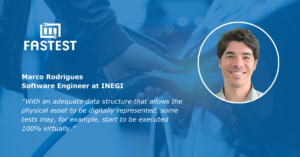
“With an adequate data structure that allows the physical asset to be digitally represented, some tests may, for example, start to be executed 100% virtually.”
Marco Rodrigues is Software Engineer at INEGI, the Institute of Science and Innovation in Mechanical and Industrial Engineering, which based in Portugal. His wide knowledge about digital twins is shown in this interview, where he outlines the main uses and processes that imply a digital twin (DT) within the FASTEST project.
.
1. When it comes to battery production, what is a digital twin (DT)?
A digital twin can be seen as a digital representation of a physical asset. This physical asset should be capable of generating/producing data – this is the only constraint.
The DT can be composed of several digital modules, with different objectives each, which in the end, all collaborate together to achieve certain purposes – for example, detecting inefficiencies in a production stage of the batteries.
The main concern when building the DT will be to ensure that it has a digital data structure that reliably represents the tests in the battery production process. If this structure is reliable, we will have a solid basis for applying technology solutions (such as artificial intelligence, etc.) to obtain conclusions about the tests, or even, just migrate tests to virtual benches.
2. How can a DT help to reduce the test efforts?
This can be achieved in multiple ways and will depend on the tests to be virtualized. However, with an adequate data structure that allows the physical asset to be digitally represented, some tests may, for example, start to be executed 100% virtually, reducing time and cost in the process.
3. What are the biggest challenges of this process?
Probably to ensure that the data structure is reliable relative to what is intended to be virtualized in the test, and ensure adequate communication and data transfer capacity, especially in tests that will be partially virtualized.
